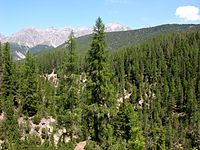
Photo from wikipedia
Fire is the predominant natural disturbance that influences the community structure as well as ecosystem function in forests. This study was conducted to examine the soil properties, loss of aboveground… Click to show full abstract
Fire is the predominant natural disturbance that influences the community structure as well as ecosystem function in forests. This study was conducted to examine the soil properties, loss of aboveground biomass, and understory plant community in response to an anthropogenic fire in a coniferous (Pinus massoniana Lamb.) and broadleaf (Quercus acutissima Carruth.) mixed forest in a subtropical–temperate climatic transition zone in Central China. The results showed that soil pH, NO3−-N concentration, and microbial biomass carbon (C) increased three months after the fire; however, there were no significant differences in soil organic C, total nitrogen (N), NH4+-N concentration, or microbial biomass N between the burned and unburned observed plots. The total aboveground biomass was 39.0% lower in the burned than unburned plots four weeks after fire. Direct biomass combustion (19.15 t ha−1, including understory shrubs and litters) was lower than dead wood biomass loss (23.69 t ha−1) caused by the fire. The declining trends of tree mortality with increasing diameter at breast height for both pine and oak trees suggest that small trees are more likely to die during and after fires due to the thinner bark of small trees and tree and branch fall. In addition, burning significantly stimulated the density of shrub (160.9%) and herb (88.0%), but it also affected the richness of shrub and herb compared with that in the unburned plots two months after the fire. The rapid recovery of understory plants after fires suggest that the diversity of understory species could benefit from low-severity fires. Our findings highlight that the decomposition of dead wood and understory community recovery should be considered for offsetting C emissions after fires for further research.
Journal Title: Forests
Year Published: 2020
Link to full text (if available)
Share on Social Media: Sign Up to like & get
recommendations!